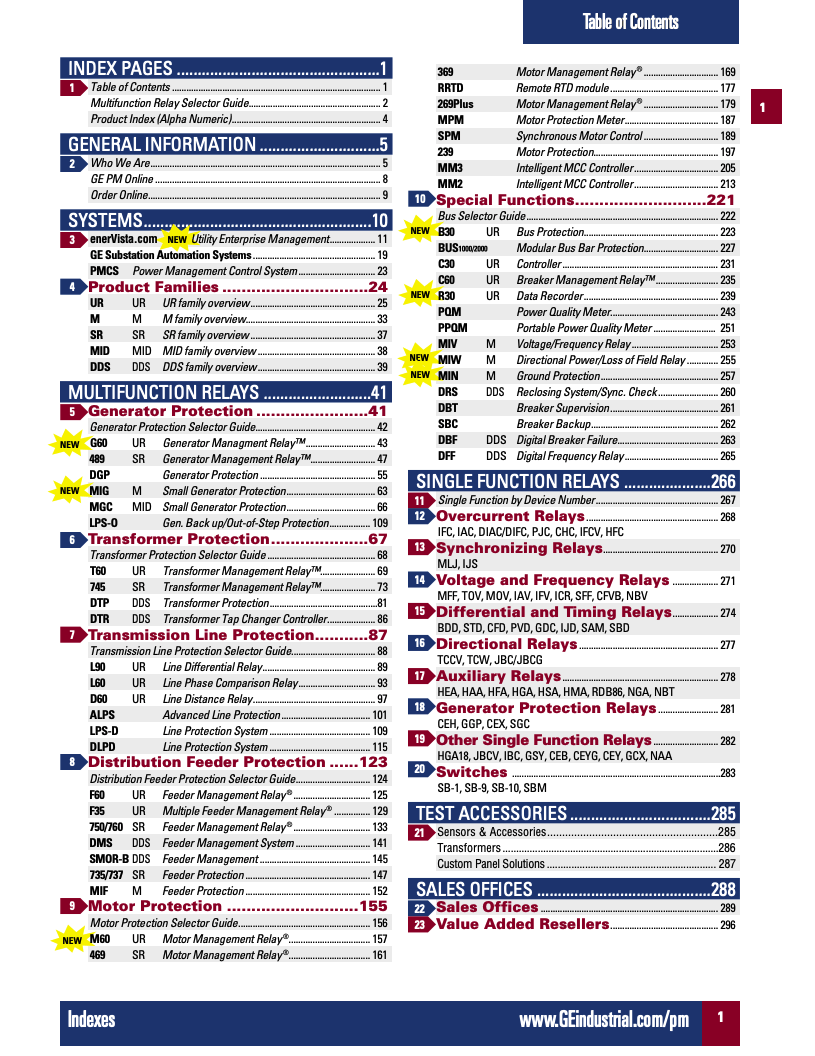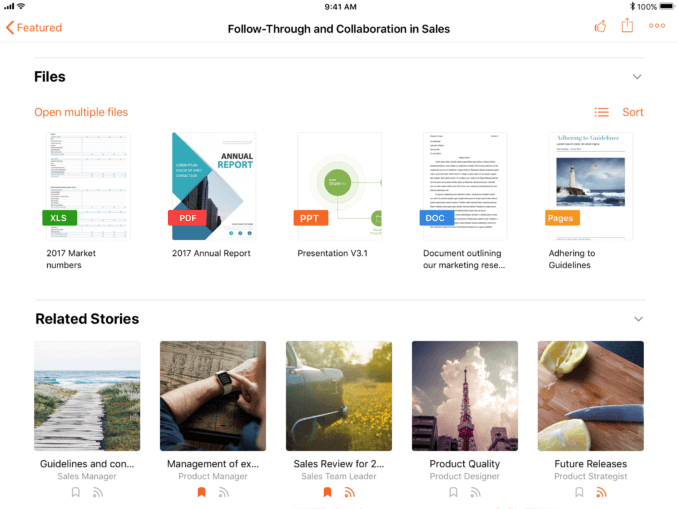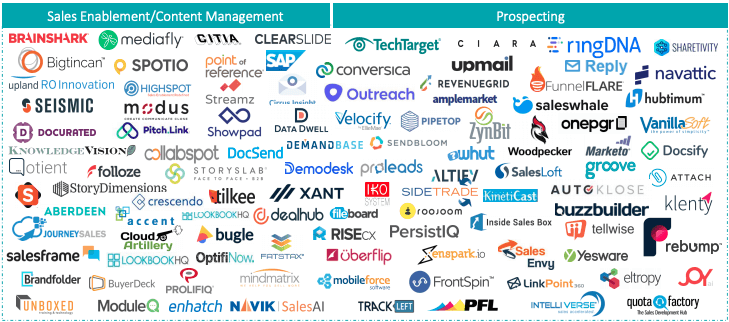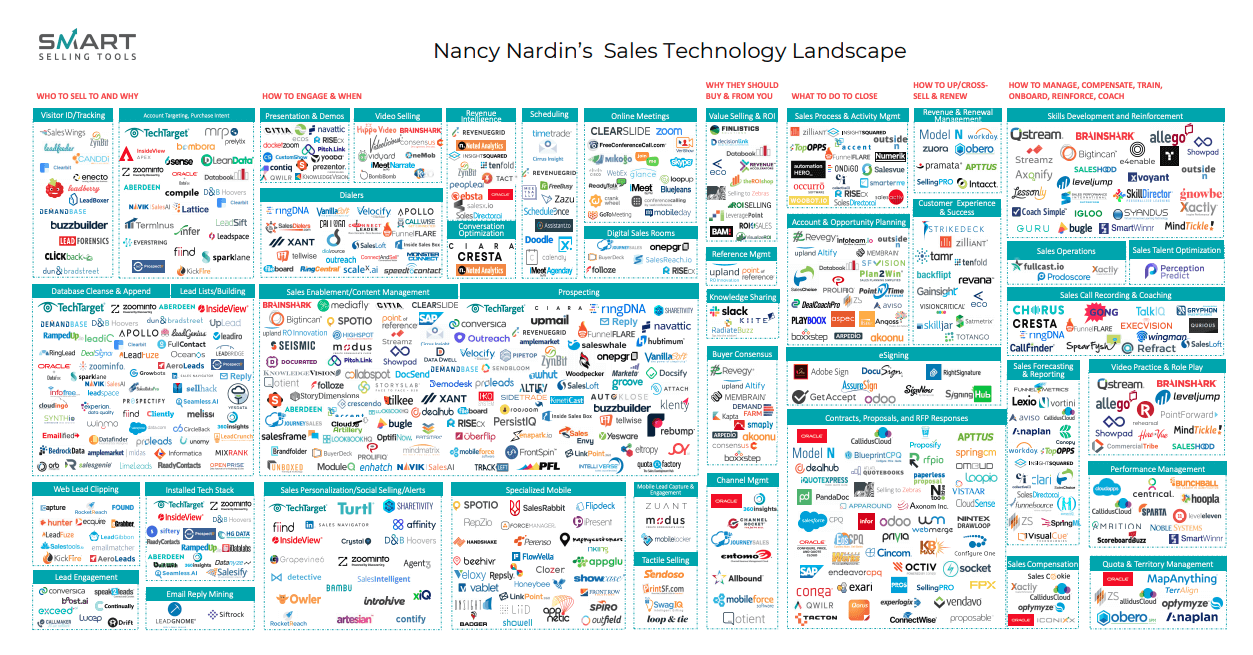Enterprise sales teams need fundamentally different software than their SMB or startup counterparts.
They don't just need a larger CRM license, or more Sharepoint storage, or another email automation software.
Instead, they need tools specifically built to manage enterprise scale, complexity, security, and governance.
This means software to help work through long sales cycles, complex and technical customer requirements, multiple stakeholders and decision-makers and vast product catalogs.
Below, we'll go over several kinds of software that sellers can use to manage these kinds of complex sales.
 To inform this piece, we interviewed Nancy Nardin, founder of Smart Selling Tools.
To inform this piece, we interviewed Nancy Nardin, founder of Smart Selling Tools.
She was named in Forbes as one of the Top 20 Social Sales Influencers, and is a recognized authority on sales technology. With more than 35 years in the sales tech industry, she brings a broad perspective on what makes successful enterprise sales teams tick.
We'll also lean on our ten-plus years of experience building sales enablement software for enterprise sales teams here at Bigtincan.
Below, we'll cover three specific kinds of tools that sellers need to use to perform at a high level and close enterprise deals, including:
- Sales Training and Coaching Tools: to help salespeople stay fresh on the differentiation and pitches for a wide variety of products and customers.
- Content Management Software: to help manage spec sheets, sales presentations, and other documents covering potentially hundreds of products and use cases.
- CRM Automation Tools: to help salespeople offload routine tasks, increase CRM usage, and have more time to work directly with customers and prospects.
We’ll also explain how we solve for these challenges using Bigtincan, give you an overview of other important SaaS and software tools to consider, and point you to a few resources on Nancy’s site for further reading.
1. Enterprise sales content management
Of all the enterprise sales software on this list, content management tools might be the most important.
Why content management is so important to enterprise sales
Enterprise sellers often have to sell dozens, if not hundreds, of products, all with different product specs, positioning, and sales information. At that scale, it’s impossible for sellers to remember all the relevant info for each product.
When sellers don’t remember relevant product information, they can’t answer customer questions immediately, which leads to slower sales cycles, more stalled deals, and lower win rates.
Still, it’s hard to expect sellers to remember every detail for every product at enterprise scale.
For example, look at this table of contents for a General Electric Grid systems product catalog, which is just one arm of the GE product family:

This isn’t even an extreme example; some of our customers have up to millions of SKUs available to sell. With this scale, there will naturally be a few products that you only sell every once in a while — say, every three months. How do you remember everything you need to know about a product you only sell four times per year?
You can’t do it.
Even if you only have ten products to sell, an enterprise sales territory might include 500 prospects, each with a different use case. And the salesperson has to have the right details on hand to sell into any and every one of these accounts at the drop of a hat.
Nancy sums up the problem nicely:
Enterprise salespeople have to navigate a vast landscape of product offerings, each with differing use-case applicability, value quantification factors and competitive strengths and weaknesses.
If they don’t have the right information on hand, reps may miss upsell or cross-sell opportunities. Even worse, they may sell products with a poor product-market fit simply because they’re more familiar with them. This leads to poor customer relationships and lower customer success rates.
How we solve for sales content management
When you have 100 products, you might have thousands of relevant documents ranging from spec sheets to presentation docs. A great content management system needs to make sure these documents can be found by sellers quickly and easily.
In our experience, and the experience of thousands of our enterprise customers, this isn’t as simple as setting up a Sharepoint site or Google Drive and dumping the relevant docs into various folders.
As we’ve discussed in detail, a simple folder-in-a-folder structure may work for 100 files, but at 1,000 or 10,000+ files at the enterprise scale, it’s untenable — it’s too slow, too disorganized, and too rigid.
Reference these posts for more on that:
- The Best Enterprise Content Management Software to Empower Sales and Marketing Teams
- How to Create and Scale a Document Management System in SharePoint (Without Hiring Extra Help)
- Mobile Content Management Solutions: Why Simple File Storage Is Inadequate
Instead, the ideal sales content management system uses AI to proactively bring content to salespeople. Here’s how that works in Bigtincan:
It starts with AI-powered search
First, the rigid, old-fashioned folder-in-a-folder system is replaced with extremely powerful search.
Say you’re working with a new buyer. You’ve had a couple discussions and want to send them something to keep them engaged between meetings. You know they asked about one of your product lines and showed some interest, so you open Bigtincan and type in the name of the product line in the search bar.
When you press the search button, the Bigtincan AI-powered search engine considers your search and pulls in information from your CRM and company-wide sales data, including:
- The buyer’s industry
- How many meetings you’ve had with the client
- Which documents are used most by the highest performing account executive on your team
- Which documents you’ve used in similar situations
- And more
It also does a full-text search to see if your search term is mentioned in any document text (not just the file name), and makes sure all documents under consideration are the latest version (even if they were just updated by marketing yesterday).
Then you’re presented with a list of results, prioritized by relevance and potential performance.
You just select the ones you want and send.
A central, customized content repository
In our experience, marketing, sales, customer success, and other teams all have different methods and repositories for storing and organizing content. Marketing might store all docs in one Sharepoint folder, while the sales team uses three folders spread across different repositories to support their sales process.
Bigtincan is a differentiator
Bigtincan plugs into all of these repositories and pulls them into one customizable and easy-to-use interface, meaning, organizations do not need to change their normal workflows of where content is stored.
Bigtincan can still access all of the files (with it’s powerful search and other capabilities) regardless of where they live — as compared to most competitors, who require that you use their proprietary systems to store your content.

See the row labeled “Related Stories” in the screenshot above? That section could be:
- Static: Only shows files you manually place there
- Dynamic: Updates based on file criteria, such as version number or tags to name a few
- Powered by AI: Contains content suggestions for each specific member based on an AI-powered process similar to what we explained previously
Each team can choose what they want each page to look like. (The Bigtincan customer success team will help you custom tailor this to fit your processes and workflows, not ours.)
Complete offline and mobile functionality
Offline and mobile functionality may seem trivial and normal today, but a shocking number of sales software options are limited offline or on mobile phones and tablets. We designed Bigtincan for the average salesperson — who is often on the road, at a client site, and other places with limited or no connection — so that all of the most important features are available both offline and on mobile.
Even the AI-powered search is available offline. Plus, the AI features will help you manage which files should be downloaded to local storage on your mobile devices.
For example, if you have a presentation downloaded to your tablet and the marketing team updates it, Bigtincan will automatically replace the old version with a new file.
Other Content Management Tools
To get a feel for how many content management tools exist today, take a look at the Nancy Nardin SalesTech Landscape — a graphic that maps enterprise sales tools into useful categories:

Notice that there is some overlap between prospecting tools and sales content management tools (also called sales enablement tools). That’s simply because many tools fill both needs.
If you’d like a short list of tools to consider, look no further than Nancy’s “Top Sales Tools of the Year 2020 - The Final Cut,” which lists the following as the top Sales Enablement and content management solutions of 2020:
- Bigtincan (that’s us!)
- ClearSlide
- Crescendo
- Mediafly
- StitchView
- StorySlab
Check out the full resource for more information.
2. Enterprise training and skills development software
Even if your reps have all the right content at their fingertips, they still need to know how to use it to sell effectively. And it’s no secret that sales training is critical for company growth.
Consider a sales team with hundreds or thousands of reps who are all 10% better at:
- Pitching products
- Upselling
- Closing
- Product knowledge
Even this incremental change can make a multi-million dollar difference.
One great way to give your sales team an edge in sales training is by improving the platform they use. Too many sales training platforms we’ve seen are either unengaging, or require reps to absorb a ton of information in a relatively short amount of time.
Tell us if this sounds familiar:
Once a quarter, product marketing and sales teams meet during a sales retreat. For a whole afternoon, the product marketing team briefs the reps on the new products and features, in incredible detail.
Then the sales team is expected to remember all of the info until the next quarter.
Instead, they remember one or two takeaways and forget the rest of the info.
There’s a better way to implement ongoing training.
One of the best ways to improve training is to make it easy for reps to access information wherever and whenever they need it. One way to do that is by using a concept called microlearning.
How we solve for sales training
Bigtincan Learning (our sales training platform) is optimized for microlearning. Microlearning consists of a series of short videos that are meant to be consumed on an as-needed basis, whenever and wherever the learner needs them.
Rather than trying to download a quarter’s worth of information into a sales rep’s head in an afternoon, which many organizations do, the product team can use Bigtincan to create videos that go over one or two features and last two to five minutes each.

Sales leaders can then assign these videos, or just keep them open for as-needed use. The reps can watch these videos on any device, on- or offline, and revisit as needed. For example:
- Sales reps can see how the top rep pitches a particular product in quick videos
- Reps can brush up on specific details or seldom-used SKUs prior to a presentation
- Reps on the retail floor can brush up on new/latest products in 1 to 2 minutes while on the job (described in detail here)
Bigtincan is also optimized for adaptive learning to make sure your reps are getting the right training at the right time. In a nutshell, adaptive learning makes it possible to deliver personalized learning paths for each rep based on their progress, experience, roles, and more.
Microlearning based training — versus the traditional hours long, or days long, training sessions — is transformational for sales training.
The Bigtincan AI engine simply plugs into all of your company data sources — from CRMs to HR platforms — and uses that information to provide training suggestions to each rep.
For example, plug Bigtincan into your HR system, and it will use each seller's title information to suggest content. So your brand new salesperson might see suggested videos about CRM usage, while an SVP of Sales will be recommended content on how to lead effectively.
Together, micro- and adaptive learning help sellers learn more effectively, so they can answer buyer questions, improve the customer experience, and increase confidence and sales performance.
Other enterprise sales training tools
Other tools recommended by Nancy in the skills development and reinforcement arena include:
Read the full 2020 Top Selling Tools report for more information.
3. CRM automation tools for enterprise sales teams
If you ask Nancy, one of the most glaring mistakes that enterprise leaders make is ignoring automation when trying to improve seller productivity.
Typically, when sales leaders think “automation,” they think of functionality like:
- Email customization and sequences
- Automatic form responses
- Call and task reminders
- And other features you’d find in a CRM like HubSpot or Salesforce.
But even with these tools in hand, the average seller only spends about 35% of their time selling. Many sales enablement tools expand this functionality with document generation, automatic CRM logging, and other tracking features.
In our customers’ experience, even small applications of these automation capabilities can have a dramatic impact on both the seller’s workday, and overall company revenue.
“If you can use technology to move that needle from 35% to 50%,” says Nancy, “that’s not a 15% improvement — that’s a 43% increase in the amount of time spent with customers.”
If you extrapolate that to a million dollar territory, it could result in another $430,000 in revenue from a single salesperson.
CRM automation in Bigtincan
Bigtincan can help sellers automate and improve CRM usage. For example, instead of just training the sellers to enter information into a CRM, leaders can use AI to help automate menial logging.
In Bigtincan, these kinds of logging activities are logged automatically. If you share a document with a prospect from Bigtincan, you can check your CRM right afterwards and see that the task is already on your prospect record.
This kind of automation extends to other tasks as well, including meeting, conversation, and time tracking.
As a bonus, when these tasks are automated, CRM adoption rises, and company leadership has better data to help guide their sales teams.
“That’s the number one pain point [for company leaders],” says Nancy, “They say ‘Well, our sellers don’t enter information, and therefore we don’t have the data we need to really understand the business.’”
But using automation can help companies take a big step towards better adoption and more accurate insights.
Other enterprise CRM automation tools
CRM automation tools are typically part of a larger sales enablement platform, not a standalone tool. For this reason, they’re not included as a dedicated category in Nancy's Top Selling Tools Report.
If you’re interested in this kind of functionality, you should look for Sales Enablement software, and make sure it has the automation features you need.
We offer these features in Bigtincan, but they’re also present in other sales enablement tools such as Seismic, Showpad, and Highspot.
Other must-have enterprise sales tools
We only covered three must-have tools in this article, but there are many others that are crucial to running a smooth sales operation.
For example, Nancy includes “account targeting and purchase intent” in her list of crucial enterprise sales software because it helps sellers decide which accounts to target in the first place. Here are a few examples of these account targeting and purchase intent tools for reference:
For a full list, check out Nancy Nardin’s Sales Technology Landscape. The landscape includes practically every sales tool in existence today, sorted into 43 distinct categories.
Click the image above to see a zoomed in view of all the recommendations.
Beyond the tools you’ve seen in this article, the report includes software recommendations in five categories, including:
- Closing Deals
- Enabling Sales (included in the “Enterprise Content Management Software” section above)
- Engaging Leads and Prospects
- Targeting Accounts
- Upskilling Reps (included in the “Enterprise Training and Skills Development Software” section above)
Get a demo of Bigtincan
Again, Bigtincan specializes in sales enablement, content management, and training for enterprise sales teams. We help you make sure your sellers have the right content at the right time, along with up-to-date training, while giving your company leaders the data they need to make informed business decisions.
If this is what you’re looking for, we encourage you to request a custom demo, where we can learn the exact needs of your organization and show examples of how Bigtincan can help improve your enterprise sales process.

